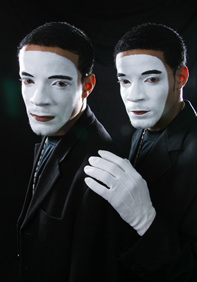by Lena Fields-Arnold
History of Mime
Mime all began in Greece, at the Theatre of Dionysus in Athens. Actors wore masks and performed outdoors, before audiences of 10,000 or more, at festivals to honor the God of theatre, Dionysus. (The History of Mime p1, p1) Dionysius also known as Bacchus was the god of theatre, wine, revelry, fecundity and homosexuality. Mime performances were used exclusively by pagan cultures for vulgar shows often accompanied by music and ending in perverse and homoerotic sexual acts. So vulgar, pantomime was condemned by the famous Greek orator, author, and priest of Zeus; Publius Aelius Aristides Theodorus. (Moffett 2015 para 1).
The Greek “pantomimus” which literally translates to “imitating all” was a highly regarded form of solo dancing often accompanied by music which encompassed both comedy and tragedy. It’s popularity was also widespread amongst the Romans until the Christian church forbade it’s public display. (What is Pantomime? 2015, p1, p1)
However, despite its sordid history, more and more Christians are embracing mime as an appropriate form of ministry and are injecting mime into praise and worship services.
Yet even as Christians, we should endeavor to explore truth from both spiritual and scholarly perspectives. “Come now, and let us reason together, saith the Lord: though your sins be as scarlet, they shall be as white as snow; though they be red like crimson, they shall be as wool.” (Isaiah 1:18, KJV) God expects His people to use their intellect to make rational decisions based on the facts of both His word and the natural world around us. We must remember that at the end of the day it is about souls being won or lost for the kingdom of Christ. Because of that, we must endeavor to ensure that our good is not evil spoken of as the Bible states in Romans, “But if thy brother be grieved with thy meat, how walkest thou not charitably. Destroy not him with thy meat, for whom Christ died. Let not then your good be evil spoken of: For the kingdom of God is not meat and drink; but righteousness, and peace, and joy in the Holy Ghost.” (14:15-17, KJV public domain)
When Christians were being persecuted under Nero and Domitian, mimes were used to ridicule the Christian faith on stage. They mocked the Christian faith by performing naked and engaging in simulated baptisms with buttocks raised in the air. Throughout the middle ages and Renaissance eras pantomimes evolved into jesters, minstrels, bands, acrobats. So pervasive were they that in AD 791, the English priest Alcuin (Alcuin of York), adviser to Charlemagne the Great, and among Europe’s intellectual elite; wrote a warning to a friend stating, “The man who brings actors and mimes and dancers to his house knows not what a bevy of unclean spirits follow them.” (The Roman Christian Church – It Spectacular Elements Originally Published 1935, Republished on oldandsold.com)
Vase illustrations demonstrate that the representation of naked women on the comic stage was also accomplished by ‘genital tights’ with artificially represented pubic hair. Given that adultery and other sexual themes became synonymous with the mime in the Roman Empire, it seems the simulated sex of the mime would be represented with this degree of realism. The erotic component is present in descriptions of mime from the very beginning. (Brockett & Franklin Chp 3)
According to performance artist Billy Krahl, mime actors would concentrate more on the development of their characters, than the plot itself [emphasis added]. This statement takes on a new meaning when we delve more into masks/face painting and their relationship with past and modern day mime.
Krahl himself acknowledges that the Christian church showed great opposition to the “bawdy, and often indecent associations of Mime, and excommunicated all performers, and closed down all the theatres.” (Krahl para 6)
Pantomime later re-emerged as a dominant art form in France where Jean-Gaspard Deburau “immortalized” the silent Pierrot pantomimes (Lust)-a lazy, grotesque, mischievous, male character in white– wearing clothing similar to modern day clowns. He is credited with introducing the white painted face. (2003 para 7)
A lot of people don’t like clowns. There is no shortage of clowns and masked villains who are either featured in scary movies and books; or are the central character. Have you ever wondered why? Linda Rodriguez McRobbie, in her article “The History and Psychology of Clowns Being Scary” for Smithsonian (July 31, 2013 p1) tells us that the history of clowns is a sordid one-rooted in ancient pantomime and that people have been frightened by clowns for centuries.
In her article, Rodriguez further delves into the dark history of clowns and shows us how almost every culture has had clowns (pantomime) of some sort. Rodriguez stated, “Well into the 18th and 19th century, the prevailing clown figure of Western  Europe and Britain was the pantomime clown, who was a sort of bumbling buffoon.” Rodriguez further notes that Grimaldi like many other famous clowns was prone to bouts of depression and associated with tragedy.
Europe and Britain was the pantomime clown, who was a sort of bumbling buffoon.” Rodriguez further notes that Grimaldi like many other famous clowns was prone to bouts of depression and associated with tragedy.
Mime in the black church is believed to have begun in the 1980’s when a Christian believer named Mrs. Donna Darwin Ilochi had a literal “vision” for a ministry where performers danced in white painted face. (Faced 2009.) However, this information is untrustworthy as most of that information is found on blogs, with no credible sources.
Throughout the 1990’s mime began to slowly spread in evangelical Christian circles. The current gospel mime trend is most often credited to brothers Keith and Karl Edmonds of K&K Mime, who began to “popularize” the art form. (Detroit Free Press 2012)
Coming Next-Mindless Entertainment or Christ Honoring Ministry?


Pingback: Is Mime Appropriate in the Christian Church? Part 3 – Stuff Inside My Head
How could something that started so bazar and vulgar even be considered
appropriate to be used in a Christian Church?
LikeLike
My thoughts as well. Thank you for commenting.
LikeLike